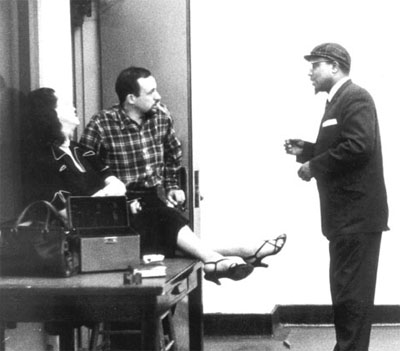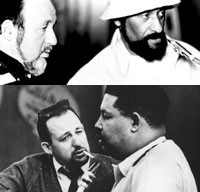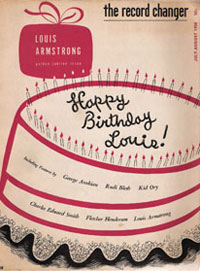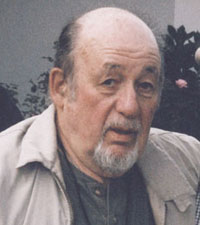|
|
|
FEATURES
A Life in Jazz
Orrin Keepnews ’43 has spent a half-century as a jazz producer,
writer and editor, earning five Grammy Awards, including one for
lifetime achievement
By Jesse Hamlin
| 
|

|
Orrin Keepnews ’43 says
he not only learned the music business producing albums featuring
Thelonious Monk (above), but also life lessons from the bebop
pioneer, "who stayed true to himself."
PHOTO: COURTESY OF FANTASY, INC. |
 |
Orrin Keepnews ’43 returned to Columbia in fall 1946, burned
out from flying bombing missions over Japan in the final months
of World War II and eager to engage his mind in loftier pursuits
before getting a job.
Finding an apartment in Manhattan was just as hard then as now,
so Keepnews moved back in with his parents at Broadway and 115th
Street and enrolled in graduate school in English. Returning to
campus after three years as a B-29 radar operator in the Pacific
— an experience that made him a lifelong pacifist —
Keepnews became close with a guy he’d known only by name during
their undergraduate years, Bill Grauer ’43. Grauer was an
avid jazz record collector who worked at WKCR and with whom Keepnews
would later start what became one of the most important modern jazz
labels of
the 1950s and ’60s, Riverside Records, which was founded in
Columbia’s shadow on LaSalle Street.
“I enrolled in graduate school for the express purpose
of making myself feel literate again,” says Keepnews, a renowned
record producer whose 50-year career with great artists such as
Thelonious Monk, Bill Evans, Wes Montgomery, Sonny Rollins and
Cannonball Adderley recently earned him a fifth Grammy award, this
one for lifetime achievement. “I wasn’t looking for
a master’s degree. I figured I’d go to Columbia for
however long it took me to feel, ‘Hey, I’m now capable
of going back into the world I wanted to be in,’ and then
I’d look for a job, which is pretty much what happened.”
Keepnews had no idea at the time that his friendship with Grauer
would lead him into the financially precarious but creatively rewarding
world of jazz recording, where he’s still active at 81.
Keepnews’ recent output in years has included major reissues
of Ellington and Basie and a sensational five-CD Artie Shaw box
released in 2001, as well as new records with artists such as tenor
saxophonist Dave Ellis and singer Roberta Donnay. He’s also
produced singer Weslia Whitfield’s records for more than a
decade.
A Bronx-born Manhattanite, Keepnews went to P.S. 98 in Inwood, which
was then a largely undeveloped middle-class enclave of Irish and
Jewish families. His mother was a teacher and his father worked
for the welfare department. “We weren’t as desperate
as most people in the early ’30s,” notes Keepnews, who
studied on scholarship at the progressive Lincoln School at 123rd
and Amsterdam, run by Teachers College. A brainy child who had skipped
two grades, he was pulled back by Lincoln officials, who felt it
was important socially for a child to be with others around the
same age.
Keepnews graduated from Lincoln at 16 and went on to Columbia, where
he settled naturally into the intellectual milieu. Lincoln encouraged
its students to “think for yourself, which was a pretty radical
thing in education at that time,” Keepnews notes, and that
ethos was cultivated at Columbia. He became “that most amorphous
of things, an English major,” and began writing about music
and other subjects for Spectator, where he served on the
editorial board his senior year.
Keepnews became hooked on jazz while in high school, hanging out
at 52nd Street joints such as Hickory House, where he heard famous
artists such as Coleman Hawkins, and Nick’s in the Village,
home to New Orleans-style players such as Pee Wee Russell and George
Brunis. The legal drinking age in New York was 18 then, but the
concept of carding didn’t exist and it wasn’t hard to
belly up to the bar.
“If you were big enough to walk into a bar and put down the
75 cents or dollar for a drink, nobody asked if you were old enough,”
Keepnews recalls, sitting in the San Francisco flat where he’s
lived since the early ’70s, when he moved to the Bay Area
to run Fantasy Records’ jazz program. “Friends told
me a great place to take a date and have a cheap evening was one
of the bars on 52nd Street or Nick’s in the Village. And incidentally,
jazz music was played there. I wasn’t listening to records
very much. But I heard live jazz in my mid-teens because I was illicitly
able to hang out in these rooms. I was sucked into it and started
going even if I didn’t have a date. There was something that
reached out and grabbed me and held onto to me.”
Keepnews was seduced by the energy and beauty of music created anew
every night. He continued hanging out on 52nd Street while studying
at Columbia, where he remembers taking Mark Van Doren’s Shakespeare
course, Harrison Steeves’ comparative literature seminar and
a colloquium on great books taught by Buck Weaver, whom he fondly
remembers telling some long-winded student, “Having said that,
what have you said?” It remains “the greatest academic
put-down I’ve heard,” Keepnews, a warm, crusty character
with a brown-fringed pate and a white Vandyke beard who’s
known for his straight-talking volubility and wit, says with a laugh.
Keepnews began reviewing shows for Spectator, writing about
artists such as Pearl Bailey and Carol Channing, who performed at
the Village Vanguard, where Keepnews would produce two live recordings
in 1961 by pianist Bill Evans’ seminal trio. Keepnews recalls
how the Vanguard’s now-fabled owner, the late Max Gordon,
cut him off after two rounds of drinks. When he asked why, Gordon
replied: “The reviews you write in the college paper aren’t
really worth more than two rounds of drinks to me, but I don’t
want to see you spending your money for drinks at my prices. So
that’s why you can’t have a drink after the free ones.”
After a pause, Keepnews adds, “That was my first experience
with a club owner, and it hasn’t gotten any easier to deal
with them since.”
Keepnews recalls being on campus with his folks for an event on
December 7, 1941, when the proceedings were interrupted by the news
that the Japanese had attacked Pearl Harbor. “It was a horrible
shock,” he says, “but that fact we were being plunged
into a war was not a big surprise to anybody. You grew up knowing
it. World War II began when Germany invaded Poland in September
1939, when my life at Columbia began. During my undergraduate career,
there was the knowledge that we were all on borrowed time.”
Keepnews joined the Aviation Cadet Corps and was called up in spring
’43, a few months before graduation. By joining the service,
he was given credit toward graduation, but he wasn’t allowed
to leave his training program at the University of Vermont in Bennington
to attend Commencement.
After the war, Keepnews spent about three months at Columbia before
landing a job as a “very junior editor” at Simon &
Schuster (it was so long ago, he adds with a smile, that Mr. Simon
and Mr. Schuster were there). It was there that Keepnews met his
late wife, Lucy, then-assistant to the mystery editor. And it was
there that he rejected, among other books, the first novel of Jack
Kerouac ’44, whose The Town and the City was published
after the success of his epochal On the Road. Kerouac apparently
learned that Keepnews had rejected the book; a decade later, drunk
at the Five Spot, where Monk was playing, Kerouac and Keepnews got
into a row about which the producer remembers nothing except Kerouac’s
punch line: “The trouble with you, Keepnews, is that you don’t
like jazz.” That cracked up a usually serious young saxophonist
named John Coltrane.
Keepnews was at Simon & Schuster when Grauer asked him to edit
a magazine, The Record Changer. Grauer was the ad salesman
and had just bought the publication. Keepnews took the gig, largely
because it gave him a forum to write whatever he wanted, even if
it was mostly a labor of love. In 1951, the two published a major
piece about how RCA Victor — which had a custom record-pressing
division — had unwittingly been pressing bootleg records from
its early jazz catalog for a fly-by-night firm, Jolly Roger. RCA
officials got the idea that the Record Changer boys wanted
to lease RCA’s early Armstrong and Bechet masters for reissue,
and contacted Keepnews and Grauer about doing it. Producing records
hadn’t been on their minds, but they figured, why not?
Keepnews and Grauer became independent producers at RCA, and also
reissued 1920s Paramount recordings by Ma Rainey, Armstrong and
others on the new label they named Riverside after the magazine’s
Manhattan telephone exchange (like Artie Shaw and The Gramercy Five).
They began making contemporary jazz records in April 1954, starting
with an album by pianist Randy Weston. The next year, they signed
Monk, the great iconoclast whom Keepnews had met and interviewed
in 1948 at the Greenwich Village apartment of Alfred Lion, founder
of Blue Note Records. Monk’s mysterious and beautiful music
had spoken to Keepnews in a way that the music of other pioneers
of bebop, Charlie Parker and Dizzy Gillespie, hadn’t. It opened
his ears to modern jazz. Keepnews was amazed when he phoned Monk
several years after their only meeting to ask him to record for
Riverside, and the pianist knew who he was — the kid who’d
written the first article about him in a national publication.
“He was willing to take a chance on this new label because,
well, he wasn’t doing anything better, but also because I
was somebody who had related to him in the past,”‘ Keepnews
says. He put out a series of Monk albums in the ’50s, among
them Brilliant Corners (1956), which introduced Keepnews
to saxophonist Sonny Rollins, with whom he would work at Fantasy
in Berkeley in the ’70s, and Thelonious in Action,
recorded live at the Five Spot in 1958 with the quartet featuring
tenor saxophonist Johnny Griffin.
Like Lion and Bob Weinstock, who founded Prestige Records, Keepnews
says, “We were fans who became record companies. If you had
your own company and said you were a producer, who was going to
say you weren’t?”
Keepnews learned the ropes working with Monk, whom he calls the
greatest artist he’s been associated with. It was on-the-job
training. “Monk was not about to show any mercy. He had his
standards. I probably learned as much about living from him as I
did about music. This was a man whose music was initially ridiculed
by people who damn well should’ve known better, a man who
stayed true to himself. I learned how to conduct my life, what to
insist on for myself and of myself.
“Our goal wasn’t to sell a lot of records and get rich,”‘
continues Keepnews, whose son, Peter, is an editor at The New
York Times and whose other son, David, is in public health
planning. “Our goal was to sell enough records to make the
next one. We built something out of wanting to build, out of being
in love with the music. I don’t know if we were particularly
naive or particularly dedicated; either we were very bright or very
stupid, but we weren’t mediocre.”
Riverside went broke in 1964, a year after Grauer’s death.
Fantasy bought its catalog and acquired a later Keepnews label,
Milestones, and the producer had the rare pleasure of reissuing,
augmenting and putting out alternative takes of his earlier work.
Working with Monk, Keepnews developed a technique without being
aware of it. “I’ve always thought of myself as more
of a catalyst than anything else,” he says. “I never
played an instrument, and I finally figured out that is one of my
strengths as a producer. I’ve never felt that I was competing
with the musicians or that I could play that solo better. My job
became to provide the best possible environment in which the musicians
could express themselves. It’s not easy, and it’s never
dull.”
Keepnews came to love live recording after taping Monk live at the
Five Spot, and he had his first major hit with The Cannonball
Adderley Quintet in San Francisco, recorded live at the Blackhawk
in 1959. Eighteen months later, he recorded Evans’ groundbreaking
trio with drummer Paul Motian and gifted young bassist Scott LaFaro
on a Sunday at the Village Vanguard. The sessions resulted
in two classic discs: Sunday at the Village Vanguard and
Waltz for Debby. Keepnews knew something special was happening
because “everything was sounding right.” He wanted to
record this band, whose improvised interplay changed the shape of
trio playing, before it split up. There’d been tension between
Evans and LaFaro over the pianist’s heroin habit, and Keepnews
had a feeling this might be their last date. He was right, but for
another reason: Less than two weeks later, LaFaro was killed in
a freeway crash.
“I was never in any danger of a habit of my own because I
was supporting too many other habits,” says Keepnews, who
sometimes finds it difficult to listen to Evans’ music, just
as it pains him at times to hear Adderley and Montgomery, close
friends who died young. Other times he feels great pride and pleasure
listening to the records he made with them.
“Sometimes I’m very sad, and sometimes I feel very reminiscent,”
he says. “Unfortunately, a favorite quote is from Casey Stengel
in his later years: ‘Most people my age are dead by now.’
Well, most people a hell of a lot younger than me are dead by now.
I know and love an awful lot of dead people, and it bothers me sometimes.
But there’s nothing I can do about it, and I’m in no
hurry to join them.
“I’m not just the guy who made the Riverside Records,
although as far as I’m concerned, there are some unequaled
achievements and unequaled artists there,” Keepnews says with
pride. “I’ve been doing it right up to yesterday.”
Jesse Hamlin has written about jazz and art
for the San Francisco Chronicle for 20 years.
|
|
Untitled Document
|







